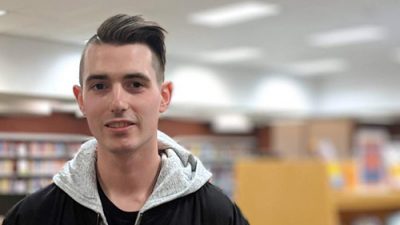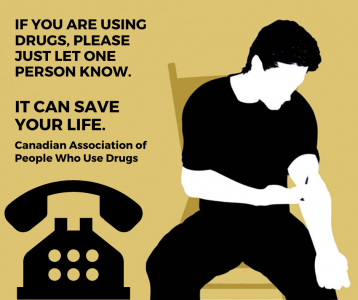How we can help keep people who use drugs alive during COVID-19

As someone who uses drugs and very recently experienced an overdose, I know how important it is to not use alone. In July, I was saved by two people who administered naloxone and performed CPR, including rescue breathing until paramedics responded. Like my overdose, most overdoses are accidental and most are preventable.
Being a person who is very open about my drug use, I feel it is my job to help change the narrative and teach people how to be safe and not use in environments that may end up killing them. This is my top priority.
Why do people use alone?
Structural and social stigma is so prevalent against people who use drugs that some people hide their drug use. People are afraid of being reported to the police or judged by their doctor or nurse, so they don’t talk about it. But if we are to prevent fatal overdose, then we need health equity for everyone, especially for marginalized people who have been facing a syndemic of overdoses, HIV and hepatitis C on top of the novel coronavirus disease (COVID-19). We need equal access to health care services and to address social determinants of health.
In order to prevent COVID-19, physical distancing has forced some people who use drugs into using alone. As a result, we have seen an increase of overdose deaths, especially in British Columbia and Ontario. That doesn’t mean people weren’t using drugs alone before, but fatal overdoses seem to be happening more now.
However, many creative solutions have been implemented to keep people who use drugs safe, and these solutions need to be scaled up and continued beyond the pandemic, to reach people who don’t live in areas with adequate harm reduction services.
Prevention methods to mitigate fatal overdose
If there is a silver lining in this pandemic, perhaps it’s the innovative ways people have kept others alive during this difficult time.
Community-based organizations and co-operatives are providing a safe place for people to use through the use of apps and telephone hotlines. So if they overdose, at the very least emergency medical services will be dispatched.
I tried one of these ways out the first time I used fentanyl during the pandemic and it kept me safe. More drug users need to know about life-saving services.
An overdose prevention hotline
Grenfell Ministries, based out of Hamilton, have created an overdose prevention hotline for people in Ontario run by peers with lived experience of drug use. Their service is available from 12 p.m. to 10 p.m. (Eastern time) and costs less than $60 per month to operate. This organization uses a network of people with lived/living experience of drug use because of the positive feedback they received from their drug-using community. This is exactly what I like to hear. More people who use drugs need to be engaged in their community of practice.
Their recently published report summarizes just how effective this overdose prevention line was. From February 1 to May 16, 2020, they received 82 calls, mostly from service providers (49) and people who wanted to prevent an overdose (14). The remainder of the calls can be broken down into support calls, questions, wrong numbers and hang-ups. Out of the 14 people who used their overdose prevention services, emergency medical services were only dispatched once, and that person responded successfully to their interventions. The 13 other people were kept safe without fear of overdose. This is spectacular and exactly what people who use drugs need.
An app that alerts your network
I want to also highlight the work of the Brave Cooperative, who designed the BeSafe Community app, allowing people to connect with other users and create networks, so that someone can call emergency services in case of overdose. It’s anonymous and your location stays secret, unless it is needed to respond to an emergency. They also have an option of closed support groups, so that only the people you choose in your network will be alerted if you overdose.
Both the overdose prevention hotline and the app are novel and noble solutions to respond to this overdose crisis in the midst of a pandemic, but also demonstrate how anyone can prevent fatal overdose anywhere at any time. The only things required are a phone and a willing supporter.
We need to get the word out
This information should be available at all safe consumption and overdose prevention sites, needle syringe programs and other community-based organizations serving people who use drugs.
A few things to keep in mind when offering or using the services mentioned above:
 Trust is key! Have open communication between the two parties.
Trust is key! Have open communication between the two parties.- The location of where the person is using is essential, but also small things like not having your door dead bolted when help arrives.
- Check in with the person who is using to see if there is someone close by with naloxone so they can intervene in case of an overdose.
- Only have what you are using out in case emergency medical services are called and police arrive on the scene (although the Good Samaritan Drug Overdose Act provides some legal protection for people who experience or witness an overdose and call emergency services).
In a perfect world, it would be nice if all Canadians could call one number any time of the day, any day of the year, but we’re not there yet. But we can focus on the harm reduction tools we do have and how communities are spearheading these grassroots approaches locally.
As we prepare for a possible second wave of COVID-19, we are going to experience more overdoses. It’s vital that we look out for one another. People who use drugs need more allies and supporters to access healthcare services, such as HIV and hepatitis C testing and treatment. But above all, we need to stay alive.
For more about community-driven harm reduction programs in Canada during COVID-19, watch this webinar.
Matthew Bonn is the program coordinator with the Canadian Association of People Who Use Drugs, a member of the Halifax Area Network of Drug Using People, the lead substance use culture expert with Peers Assisting & Lending Support and national board member of Canadian Students for Sensible Drug Policy. He is also the co-founder of the HaliFIX Overdose Prevention Society and the Canadian editorial consultant for Filter, a harm reduction magazine based out of New York City.

2 Responses